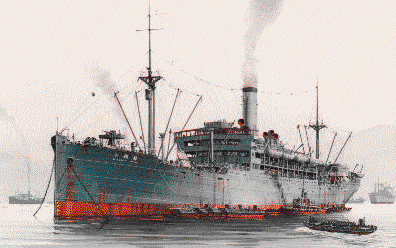
© 2010 Bob Hackett, Sander Kingsepp and Peter Cundall
29 November 1944:
Osaka. Laid down at Naniwa Dock as a 3,224-ton Type 2D Standard Merchant. December 1944:
Requisitioned by the IJN. 13 May 1945:
Launched and named MINOO. August 1945:
Kure Navy Yard. Begins conversion to a minelayer. LtCdr Horiguchi Hiroyoshi (60) is appointed Chief Equipping Officer (CEO). 5 August 1945:
Completes conversion and is registered as an auxiliary minelayer in the Kure Naval District. Assigned to the 1st Escort Fleet, 7th Fleet. LtCdr Horiguchi is appointed Commanding Officer. August 1945:
Kure. Surrendered. 5 October 1945:
Removed from the Navy List. LtCdr Horiguchi is relieved as CO. 1 December 1945:
Assigned to the Allied Repatriation Service.[1] 8 December 1945:
Enters dockyard at Innoshima for repairs. 30 March 1946:
Undocked. 22 April 1946:
Departs Saeki. 25 April 1946:
Arrives Shanghai. Embarks troops and passengers to be repatriated and departs later that day. 29 April 1946:
Arrives Hakata. Disembarks troops and passengers. 30 April 1946:
Departs Saeki. 1 May 1946:
Arrives Shanghai. Embarks troops and passengers to be repatriated and departs later the same day. 4 May 1946:
Arrives at Sasebo. Disembarks troops and passengers. 26 May 1946:
Departs Sasebo. 29 May 1946:
Arrives at Shanghai. Embarks troops and passengers to be repatriated. 30 May 1946 Departs Shanghai. 1 June 1946:
Arrives at Sasebo. Disembarks troops and passengers. 10 June 1946:
Departs Sasebo. 14 June 1946:
Arrives at Shanghai. Embarks troops and passengers to be repatriated. 15 June 1946:
Departs Shanghai. 17 June 1946:
Arrives at Sasebo. Disembarks troops and passengers. 20 June 1946 Enters Dockyard at Sasebo for repairs. 19 July 1946:
Undocked. 23 August 1946:
Departs Sasebo. 27 August 1946:
Arrives at Korojima near Tsientsin. Embarks troops and passengers to be repatriated.
Departs Korojima. 9 September 1946:
Arrives at Hakata. Disembarks troops and passengers. 16 September 1946:
Departs Hakata. 21 September 1946:
Arrives at Korojima. Embarks troops and passengers to be repatriated. 24 September 1946:
Departs Korojima. 29 September 1946:
Arrives at Hakata. Disembarks troops and passengers. 10 October 1946:
Enters Dockyard at Sasebo for repairs. 22 October 1946:
Undocked. 27 October 1946:
Departs Sasebo. 30 October 1946:
Arrives at Okinawa. Embarks troops and passengers to be repatriated. 1 November 1946:
Departs Okinawa. 2 November 1946:
Arrives at Sasebo. Disembarks troops and passengers. 7 November 1946:
Departs Sasebo. 9 November 1946:
Arrives at Okinawa. Embarks troops and passengers to be repatriated. 11 November 1946:
Departs Okinawa. 13 November 1946:
Arrives at Sasebo. Disembarks troops and passengers. 27 November 1946:
Departs Sasebo. 29 November 1946:
Arrives at Okinawa. Embarks troops and passengers to be repatriated. 1 December 1946:
Departs Okinawa. 3 December 1946:
Arrives at Sasebo. Disembarks troops and passengers. 10 December 1946:
Departs Sasebo. 12 December 1946:
Arrives at Okinawa. Embarks troops and passengers to be repatriated and departs later that day. 13 December 1946:
Arrives at Sasebo. Completes repatriation duties. During her voyages, MINOO repatriates 3,224 former Japanese servicemen. January – April 1947:
Innoshima. Scrapped at Urabe.
Authors' Notes:
[1] Allied occupation forces were responsible for the return of six million Japanese military personnel and civilians from Japan's defunct far-flung Empire. In addition, there were over a million Korean and about 40,000 Chinese prisoners and conscript laborers and approximately 7,000 Formosans and 15,000 Ryukyu Islanders to be repatriated. Some Allied and many former IJN warships, from aircraft carriers to kaibokan, were used to facilitate the enormous repatriation effort. Japanese vessels and crews were used to the fullest extent possible to conserve Allied manpower and accelerate demobilization. Each ex-IJN ship first had to be demilitarized; guns removed or, in the case of large warships, barrels severed, ammunition landed, and radar and catapults removed, if fitted. Repatriation of the Chinese on Japanese ships began early in October from Hakata, but U.S. guard detachments had to be placed on many ships to prevent disorder because the Japanese crews could not control the returnees. Japanese-run repatriation centers were established at Kagoshima, Hario near Sasebo, and Hakata near Fukuoka. Other reception centers were established and operated at Maizuru, Shimonoseki, Sasebo, Senzaki, Kure, Uraga, Yokohama, Moji and Hakodate. Allied line and medical personnel supervised the centers. Incoming Japanese were sprayed with DDT, examined and inoculated for typhus and smallpox, provided with food, and transported to his final destination in Japan.
-Bob Hackett, Sander Kingsepp and Peter Cundall

